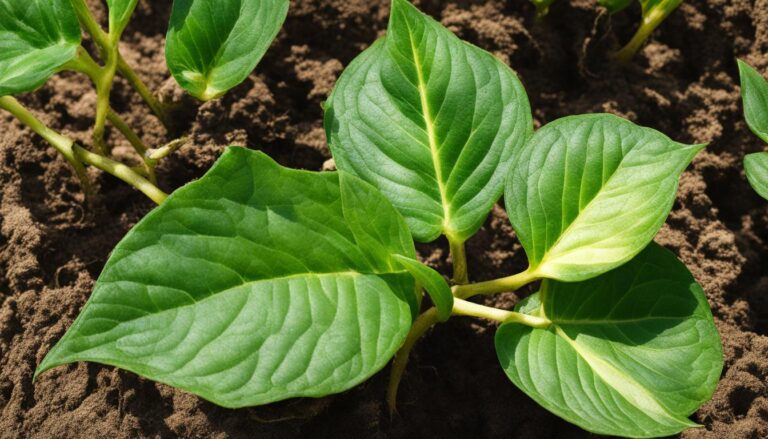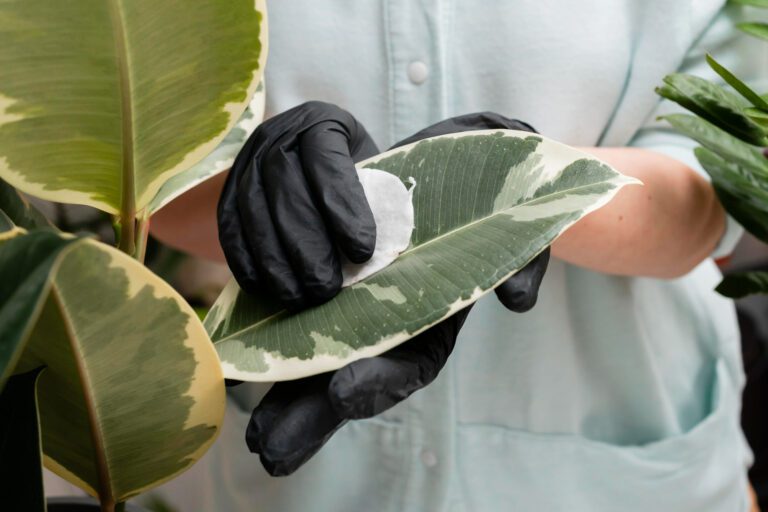
Indoor gardening is not only a hobby but also a way to enhance our well-being. Did you know that house plants can actually strengthen our immune systems?
By taking care of our indoor plants and providing them with the right conditions, we can boost their immune system and prevent plant diseases. Here are some valuable indoor gardening tips on how to improve the immune system of your indoor plants.
Key Takeaways:
- Indoor plants have the ability to boost our immune systems and improve our overall well-being.
- By improving respiratory health, speeding up recovery times, and increasing natural killer cells in the body, plants can help strengthen the immune system.
- Choose air-purifying plants like Calatheas, Mother-in-Law’s Tongues, and sweetheart plants to improve indoor air quality and respiratory health.
- Plants in healthcare environments have shown to positively impact healing and recovery.
- Incorporate immune-boosting plants like Aloe Vera, Spider Plants, and Snake Plants to strengthen the immune system and improve overall health.
Best House Plants for Improving Respiratory Health
When it comes to improving respiratory health, certain house plants have proven to be highly effective. Not only do they add beauty and greenery to your indoor space, but they also help purify the air and increase humidity levels, creating a healthier environment for you and your family.
Let’s take a look at some of the best house plants known for their air-purifying qualities and their ability to enhance indoor air quality.
Air-Purifying Plants
One of the key benefits of having house plants is their ability to filter volatile organic compounds (VOCs) from the air. VOCs are commonly found in household products such as cleaning supplies, paints, and furniture.
By having plants like Calatheas, Mother-in-Law’s Tongues, and sweetheart plants, you can effectively reduce the levels of VOCs in your home, leading to improved indoor air quality.
These plants have been shown to absorb harmful chemicals and release oxygen, making them excellent choices for those looking to boost respiratory health.
Humidity-Boosting Plants
In addition to air purification, certain house plants can also help increase humidity levels in dry indoor environments. Rainforest plants such as Areca Palms, Philodendrons, and Elephant Ears are known for their ability to add moisture to the air.
This is especially beneficial for those living in areas with low humidity or during the winter months when indoor heating systems can dry out the air.
By incorporating these plants into your space, you can create a more humid environment, which can help soothe respiratory issues and alleviate dryness in the throat and nasal passages.
| Plant Name | Benefits |
|---|---|
| Calatheas | Absorb VOCs and release oxygen |
| Mother-in-Law’s Tongue | Filters toxins and adds oxygen |
| Sweetheart Plant | Improves air quality and humidity |
| Areca Palm | Increases humidity levels |
| Philodendron | Enhances air moisture |
| Elephant Ear | Moisturizes indoor air |
By incorporating these air-purifying and humidity-boosting house plants into your indoor space, you can significantly improve respiratory health and create a more comfortable living environment.
Not only will you enjoy the aesthetic appeal of these green companions, but you’ll also reap the benefits of cleaner, fresher air and optimal humidity levels.
Plants That Speed Up Recovery Times
When it comes to healing and recovery, the presence of plants can have a significant impact. Numerous studies have shown that hospital patients who have access to houseplants or a view of nature tend to recover at a faster rate than those who don’t. The calming and soothing effect of plants can aid in the healing process, promoting a sense of tranquility and well-being.
Plants not only provide visual appeal but also offer various therapeutic benefits. The greenery and natural elements help create a healing environment that can positively influence patients’ mental and physical well-being. The connection with nature has been shown to reduce stress, anxiety, and even pain levels, allowing for a more holistic approach to recovery.
Incorporating healing plants into healthcare settings can improve patient outcomes and overall satisfaction. From leafy green varieties like Spider Plants and Boston Ferns to colorful flowering plants like Gerbera Daisies and Lavender, there are a wide range of options to choose from.
These plants not only add beauty to the environment but also contribute to improved air quality, helping to purify the surrounding air and promote better respiratory health.
The healing power of nature is undeniable, and by incorporating plants into healthcare spaces, we can create a more nurturing and supportive environment for patients on their road to recovery.
Healing Plants for Hospital Environments
| Plant | Benefits |
|---|---|
| Aloe Vera | Known for its healing properties and air-purifying qualities |
| Snake Plant | Filters toxins from the air and improves indoor air quality |
| Lavender | Has a calming effect and can help promote better sleep |
| English Ivy | Reduces airborne mold particles and improves respiratory health |
| Jasmine | Known for its soothing fragrance, which can help reduce anxiety |
Plants That Increase Natural Killer Cells
When it comes to boosting our immune system, certain plants have been found to have a significant impact on increasing the levels of natural killer (NK) cells in our bodies. NK cells are a type of white blood cell that plays a crucial role in our innate immune response, helping to defend against viral infections and other threats.
Research has shown that regular interaction with nature and plants can result in higher levels of NK cells. This means that incorporating immune-boosting plants into our indoor spaces can help strengthen our immune system and promote overall health. By creating an environment that fosters the growth of these cells, we can enhance our body’s ability to fight off infections.
Some examples of immune-boosting plants that have been found to increase NK cells include Echinacea, Ginseng, and Astragalus. These plants have been used in traditional medicine for their immune-enhancing properties and can be easily incorporated into our indoor gardens.
Benefits of Plants That Increase Natural Killer Cells:
- Enhancement of the body’s innate immune system
- Increased ability to fight off viral infections
- Promotion of overall health and well-being
- Easy integration into indoor gardens

| Plant | Scientific Name | Known Benefits |
|---|---|---|
| Echinacea | Echinacea purpurea | Enhances immune system, reduces inflammation |
| Ginseng | Panax ginseng | Boosts immune system, improves cognitive function |
| Astragalus | Astragalus membranaceus | Supports immune system, reduces stress |
By incorporating these immune-boosting plants into our indoor spaces, we can create a healthier and more resilient environment. Whether it’s a small potted plant on a desk or a larger plant placed strategically in a room, the presence of these plants can have a positive impact on our immune system and overall well-being.
Recommendations
Boosting plant health is essential for creating a thriving indoor environment. By following some simple indoor plant care tips, you can enhance the immunity of your green companions and promote their overall well-being. Remember to provide adequate light, water, and humidity levels to meet their specific needs.
To further strengthen the immune systems of your indoor plants, consider implementing immune-boosting techniques.
One effective method is to incorporate plants known for their air-purifying properties, such as Aloe Vera, Spider Plants, and Snake Plants. These plants not only enhance indoor air quality by removing toxins but also offer various health benefits.
Creating a healing environment is another way to support the immune systems of your indoor plants. Incorporate elements of nature, such as natural lighting and soothing sounds, to create a calming atmosphere.
Research has shown that the presence of plants in healthcare environments can positively impact recovery times, so it’s worth considering for your indoor space as well.
Taking care of our indoor plants goes beyond aesthetics; it is a way to nurture and support their immune systems. By implementing these immune-boosting techniques and providing proper care, you can ensure your plants thrive and become resilient against plant diseases and stressors. So, let’s embark on this journey together and create a healthy and vibrant indoor oasis!
FAQ
How can house plants boost our immune systems?
House plants can boost our immune systems by improving respiratory health, increasing natural killer cells, and aiding in the healing process.
Which house plants are best for improving respiratory health?
House plants such as Calatheas, Mother-in-Law’s Tongues, and sweetheart plants are known for their air-purifying qualities. Rainforest plants like Areca Palms, Philodendrons, and Elephant Ears can add moisture to the air, benefiting those with dry indoor environments.
Can house plants speed up recovery times for hospital patients?
Yes, studies have shown that patients who have access to houseplants or a view of nature tend to recover at a faster rate than those who don’t. The presence of plants in a healthcare environment can positively impact healing and recovery.
Do house plants increase natural killer cells in the body?
Yes, people who regularly interact with nature and plants have higher levels of natural killer cells. Being in environments with plants can boost the body’s innate immune system and enhance its ability to fight off viral infections.
What are some recommendations for boosting indoor plant immunity?
To boost indoor plant immunity, choose immune-boosting plants like Aloe Vera, Spider Plants, and Snake Plants. Improve air quality and create a healing environment by providing proper care, including adequate light, water, and humidity levels.







2 Comments
Comments are closed.